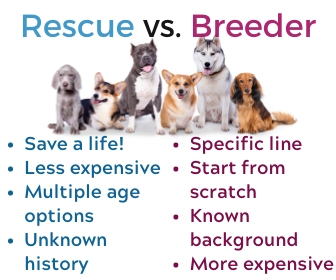Getting a puppy from a Breeder Vs. Rescue

When choosing a service dog prospect, there are two main options. Getting a puppy from a breeder vs a rescue. While it is true there are some dogs that regardless of background are natural service dog prospects, these dogs are harder to find. A rescue typically gets puppies from either unexpected litter (last litter programs), abandoned litters, stray litters and pregnant moms from county shelters. Breeders on the other hand breed for specific traits, characteristics, and personalities. Most breeders focus on what are called pure bread animals, so they are not crosses between dog types. There are some exceptions, such as the poodle crosses. These dogs are typically bread for coat and hypoallergenic reasons.
Rescues are extremely important within our culture. They rescue abandoned, abused animals, and work to give them better lives. There are also many rescues that have what are called last litter programs. Where someone who has an animal who has come up pregnant contacts the rescue, the rescue agrees to take on financial responsibility for the litter, as well as find the litter homes, and spay the mom when the puppies have weaned. This is a great program for those who have found themselves in an unexpected situation, or who realize they have gotten in over their heads. Rescues prevent puppies from being on the streets, they prevent more strays, and they ensure every animal that is adopted out of their program will be either spayed or neutered to prevent further unexpected puppies. Also, rescues typically take in animals who have been hurt or are very sick, get them vet care, and then help find them homes when possible. Rescue animals make amazing pets, and some can make great service animals.
Breeders typically go start to finish with their dogs, they often have both the male and female, and can trace lineage back quite a few generations. Most modern breeders do genetic screenings, as well as check to be sure the bone structure of their breeding animals are in good condition. This ensures that not only is the animal healthy genetically, but also that the animal will be able to continue to work in the long run without running into issues such as hip dysplasia or elbow dysplasia, which can end a service dogs career very quickly.
The issue with rescues for a service animal is this. Many of the rescues near me are only allowing a meet of a puppy at adoption day, after all necessary fees have been paid. They typically are not allowing to meet more than one puppy. This means that to find a puppy that is a service dog prospect, I have to pay a deposit on multiple animals, likely through multiple rescues, and it is still very possible the dog may not meet my needs.
Because of this, I have chosen to go with a breeder. I’ll explain how I’ve chosen a breeder in the next post.

Recent Comments